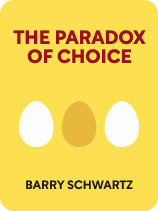

This article is an excerpt from the Shortform book guide to "The Paradox of Choice" by Barry Schwartz. Shortform has the world's best summaries and analyses of books you should be reading.
Like this article? Sign up for a free trial here .
In a life full of choices, what are some of the most complex decisions to make? What makes these decisions more difficult than others?
Complex decisions are ones that have a great impact on your life, such as which insurance to choose, which college to attend, or which job will make you the happiest. Although the outcomes of these decisions are intangible, they are some of the biggest choices you’ll ever have to make.
Let’s take a look at some of the complex decisions you’ll likely have to face.
The Choices We Make
In his book The Paradox of Choice, author Barry Schwartz explores and defines the major categories of choices—consumer choices, complex decisions, and personal life choices—and the consequences of expanded choice in each of them:
- Consumer choices are choices about consumer or tangible goods, from potato chips to computers.
- Complex decisions involve more complicated decisions about intangibles that have a greater impact on our lives than products. Examples are choosing which college to attend, which health insurance plan to choose, or which cell phone plan to purchase.
- Personal life choices are broad, long-term choices that don’t explicitly involve purchases, but instead incorporate how we want to experience our lives and present ourselves to the world. These typically involve choices about our personal relationships and our identities (religious, social, and so on).
This article will explore complex decisions at length.
Making Complex Decisions
The second category of choices is complex decisions. These are choices, relating mainly to intangible services, which have a major impact on one’s health, finances, education, and career. These are more consequential than everyday consumer choices, and since these choices are complex and often require research, it can be difficult and depleting to make informed decisions.
Utilities
Schwartz notes that a host of options exists for utilities, such as telephone and electric service. In the past, utilities like these were owned by monopolies, leaving consumers with little to no choice. For example, people could only purchase their telephone plans from one company, the Bell System.
(Shortform note: Bell was broken up in 1982, since it discouraged free-market competition. For many consumers, Bell had been the only option, and they had to lease phones and buy service from Bell. As a result, new companies and greater choice of utilities followed.)
Regulation has provided consumers with multiple options and incentivized companies to improve services and lower prices to stay competitive. On the other hand, there are many choices for phone and electric services, and it can be difficult to distinguish among companies and make informed choices. For this reason, Schwartz writes that most people stick with the plans they already have, without investigating other options (even if they could be more cost-effective or provide more reliable service).
(Shortform note: With many options and sometimes minimal information, choosing a utilities plan can be challenging, and it may lead to unintended consequences like inadvertently paying more than you did before. For example, deregulation of electric services in some states has led to a proliferation of deceptively expensive plans from power suppliers.)
Insurance
Schwartz notes that, while employees had few health insurance options in the past, companies now tend to provide employees with an array of options. If people must buy their own insurance, they have even more choices to make.
Health insurance is complicated and difficult to understand, and choosing the wrong plan could have significant consequences. There’s frequent public debate about whether the government should step in and provide health insurance to a greater extent, or continue allowing the free market to dominate the industry.
| The Challenges of Choosing a Health Insurance Plan Many countries have national health care systems, or use a combination of public and private systems. However, choosing a health insurance plan in the United States can be complicated due to the number of options available, each coming with significant trade-offs. Government-subsidized plans, for example, are categorized as Bronze, Silver, Gold, and Platinum, each with a different range of coverage. If you select a Bronze plan, your insurance will cover less of your care but your deductible will be low; on the other hand, if you select Platinum, your insurance will cover nearly all of your care, but your deductible will be very high. It could be easy for someone to get overwhelmed and miscalculate—for example, choosing a Bronze plan for the low deductible without considering that they need frequent medical care and will have to pay high rates for their appointments. Because of the complexity of choosing a government-subsidized plan, the government provides Navigators to assist people in the process. More choices abound: Choosing a network type affects which health care providers you’ll be able to see and in which areas. You can also choose whether or not to purchase dental insurance. Since these choices have a direct and significant impact on health and finances, the stakes are high, and the chooser is likely to experience stress. Re-enrolling and switching plans is an option every year, taking a bit of the pressure off, but since the decisions involved are complicated, most would not want to go through the process very often. |
(Shortform note: While utilities and insurance are important choices that take time and energy to consider, the areas of choice that follow, such as education and retirement, are generally of greater importance. People with the financial means have the opportunity to change their utilities and insurance plans if they are unsatisfied, but the complex decisions described below have more long-lasting consequences that may significantly affect the life of the chooser.)
Education
One of these vitally important choices is education. Schwartz particularly focuses on choices in higher education.
Colleges and universities in the United States previously had a more or less fixed curriculum for their students. Students generally took the same introductory courses, which gave every student a shared experience of college education.
In recent years, education has moved to accommodate students’ individual interests and pursuits. At most colleges and universities, students are able to choose their courses from a catalog of hundreds, with dozens—sometimes hundreds—of majors (and minors) to choose from.
Schwartz compares this educational model to a “shopping mall.” Most schools still have some kind of core curriculum, but even within these boundaries, there tend to be many course options. While the increase in choices in higher education allows students to follow their own goals and learn about topics they’re interested in, it also means students must make choices that will affect the rest of their lives while still teenagers.
| The choices college students must make are consequential, and many find that they regret them later on. In a 2017 survey, 36% of college graduates reported regretting their field of study. Given the importance of this decision and the young age at which most students attend college, many may be ill-equipped to make an informed decision from a large selection of majors and minors. Many college students also take out substantial loans to finance their education. Again, many graduates regret this decision: One study found that 84% of graduates born between 1982 and 2000 had some level of regret about their student loans. Loans, then, are another decision that those entering college aren’t yet prepared to make. |
Retirement
While education is a consequential decision many people make in preparation for their careers, planning for your life post-career also involves a variety of choices.
Schwartz notes that retirement planning has grown more complicated, requiring employees to make many choices about their pension plans. As with health insurance, employers typically offer employees numerous pension plan options. Plans have largely shifted from “defined benefit,” meaning that a retiree’s pension is directly correlated with their years of service, to “defined contribution,” meaning the pension results from a series of investments made by employee and employer.
Defined contribution plans provide employers and employees with potentially dozens of choices, in both high-risk and low-risk investments. Employees may not have enough prior knowledge to make an informed selection, and since there are so many investment choices available, it’s difficult for employers to provide oversight and guidance.
(Shortform note: While defined benefit plans are now uncommon in comparison to defined contribution plans, some employees may find themselves facing a choice between the two types of plans. This creates yet another high-stakes choice to make for retirement plans, and those who have to choose between defined benefit and defined contribution plans have numerous factors to consider—including which would provide a greater financial benefit and whether they want to choose their investments or stick with a stable plan.)
Medical Care
Medical care is another area where choices have proliferated and grown increasingly complex.
In the past, Schwartz writes that doctors generally dictated medical care to the patient. Even if the patient disagreed with the doctor’s advice, the doctor would typically disregard their concerns and proceed with the treatment they thought was best.
Now, rather than being told what is appropriate by medical professionals with little room for disagreement, patients are typically given more autonomy to decide what care they want to receive. This often benefits patients, as they now have more control over the care of their own bodies. However, according to Schwartz, too much choice in their medical care can overburden patients. Many people imagine they want total autonomy in their medical decisions, yet there are situations in which having to make one’s own medical decisions can cause stress and hardship.
Schwartz illustrates this point by citing a study on whether cancer patients want to choose what care they receive, conducted by physician Atul Gawande. When Gawande asked one group who did not have cancer to imagine what their preference would be, 65% of this group said they would want to choose their treatment. However, in the group of participants who actually had cancer, only 12% said they would want to choose their own treatment.
(Shortform note: Factors other than simple preference also may complicate patients’ choices about medical care. In the United States, the high cost of care increases the difficulty of making medical decisions. Recent studies found that 22% of Americans had recently skipped medical care because of the cost, and 29% had not taken prescription medicines properly for the same reason (for instance, some rationed pills to save money). Your insurance plan has a significant impact on how much you pay for medical care, which shows how closely insurance decisions and medical decisions are connected.)
Jobs
Numerous advances in technology and work culture allow many people flexibility to choose when, where, and how to work. However, Schwartz posits that these advances can also require people to make important decisions about work on an ongoing basis, rather than settling into a satisfactory job long term.
Schwartz explains that people now have greater choice over which careers to pursue. In the past, many were unable to further their education, and so were left with a limited pool of careers, often taking jobs that their parents or other family members did.
Since then, social mobility has expanded, and many more middle-class Americans can now attend college. As a result, it is more common to be able to freely choose one’s career or job.
Additionally, remote work provides professionals with the option to work from any location. Also, remote work, plus digital technologies like email, allows us to choose when to work, even if not during regular working hours.
As a result of these changes, Schwartz notes that many people choose to switch jobs many times and to constantly seek new work even while employed.
(Shortform note: While it’s a common perception that people switch jobs more than they used to, evidence doesn’t support it, according to the National Bureau of Economic Research. In fact, since the 1980s, the number of workers who stay with employers for only a brief time has declined, while the number staying for a long period has increased. This misperception may be due to the fact that men have seen a decrease in extended employment, while women have seen an increase.)

———End of Preview———
Like what you just read? Read the rest of the world's best book summary and analysis of Barry Schwartz's "The Paradox of Choice" at Shortform .
Here's what you'll find in our full The Paradox of Choice summary :
- Why the more choices we have, the more stressed and indecisive we feel
- How to better navigate our choices, from groceries to health insurance
- Whether it's better to seek the best or accept "good enough"






